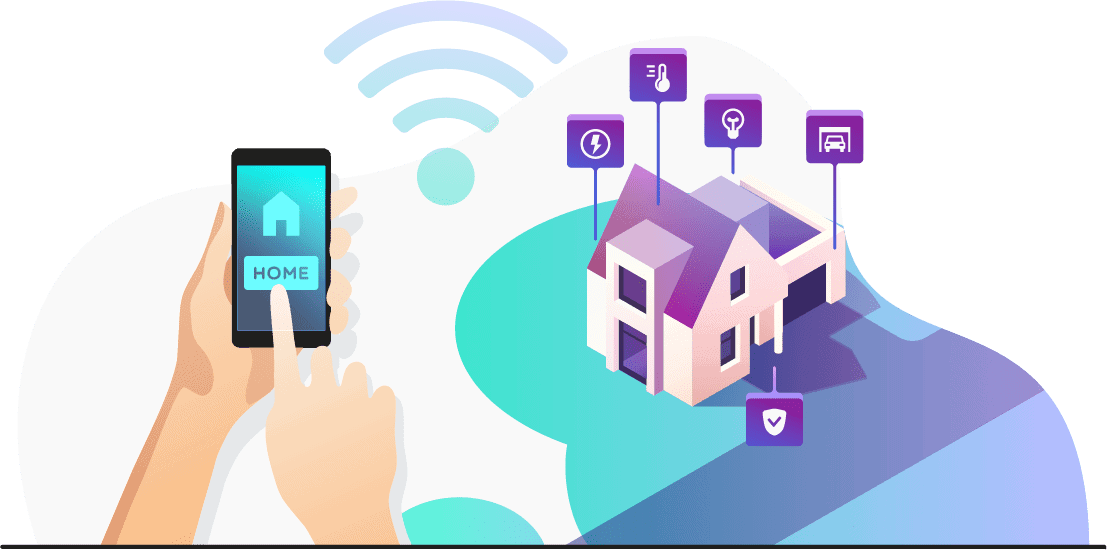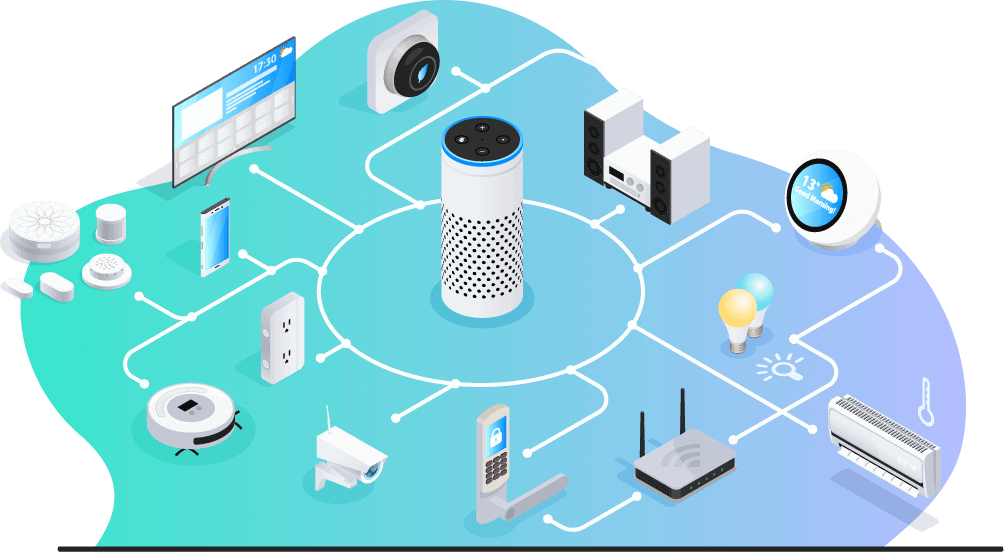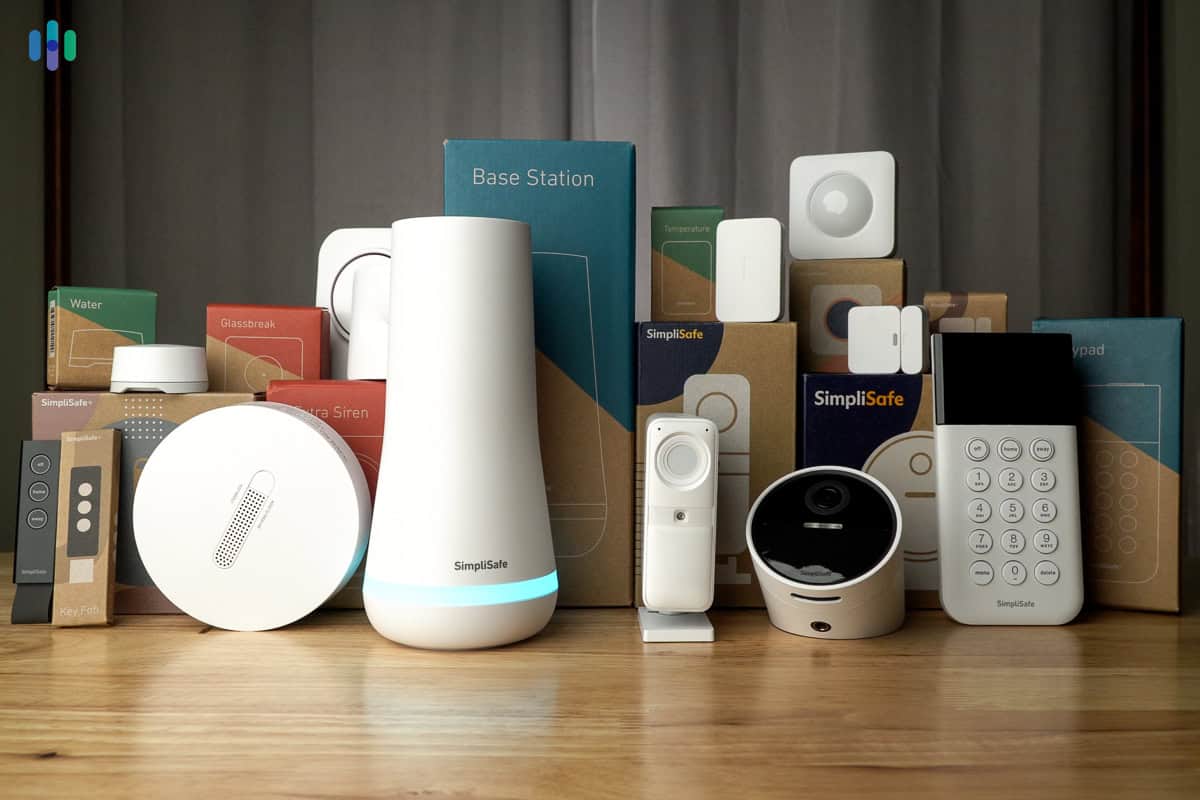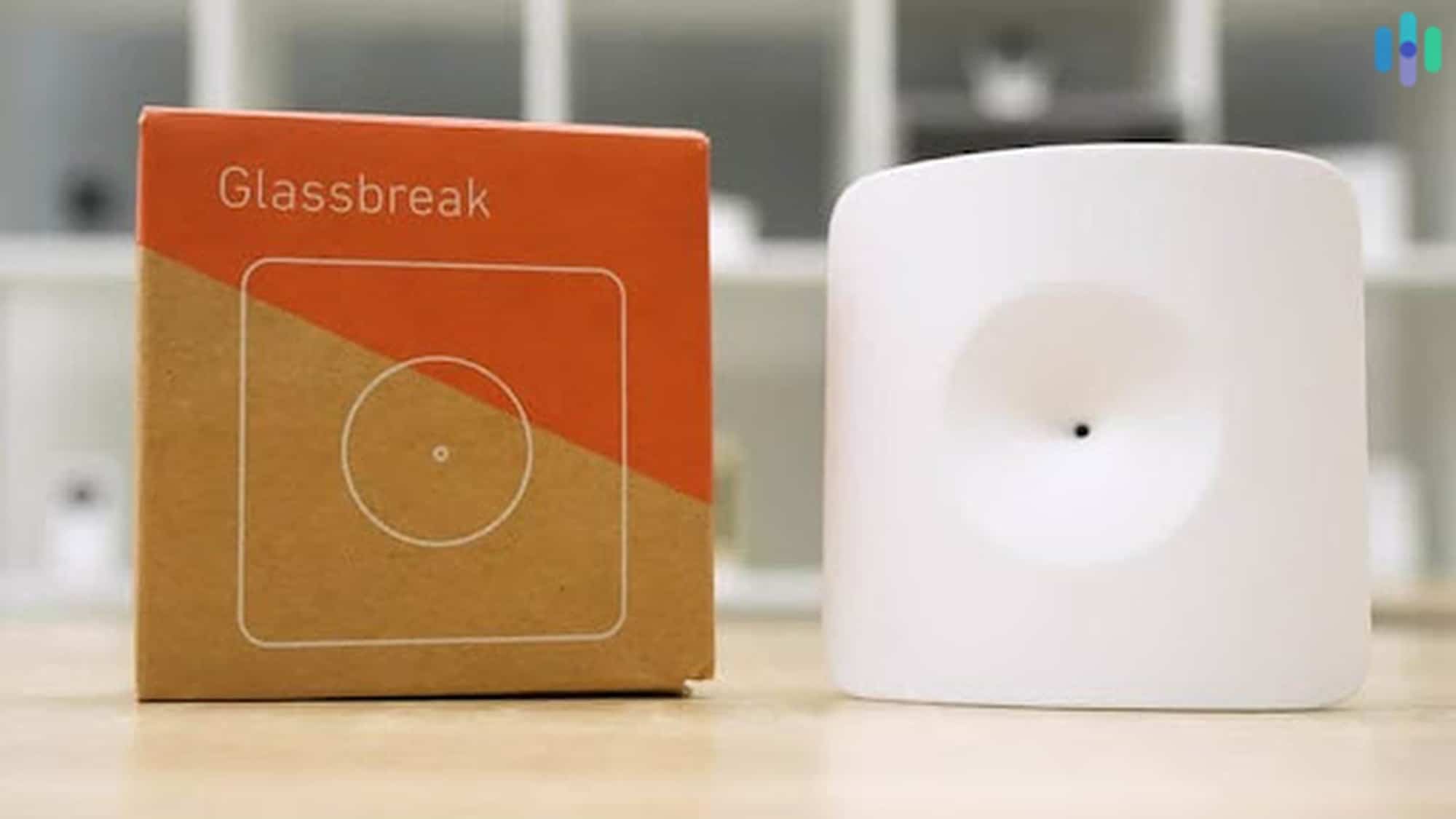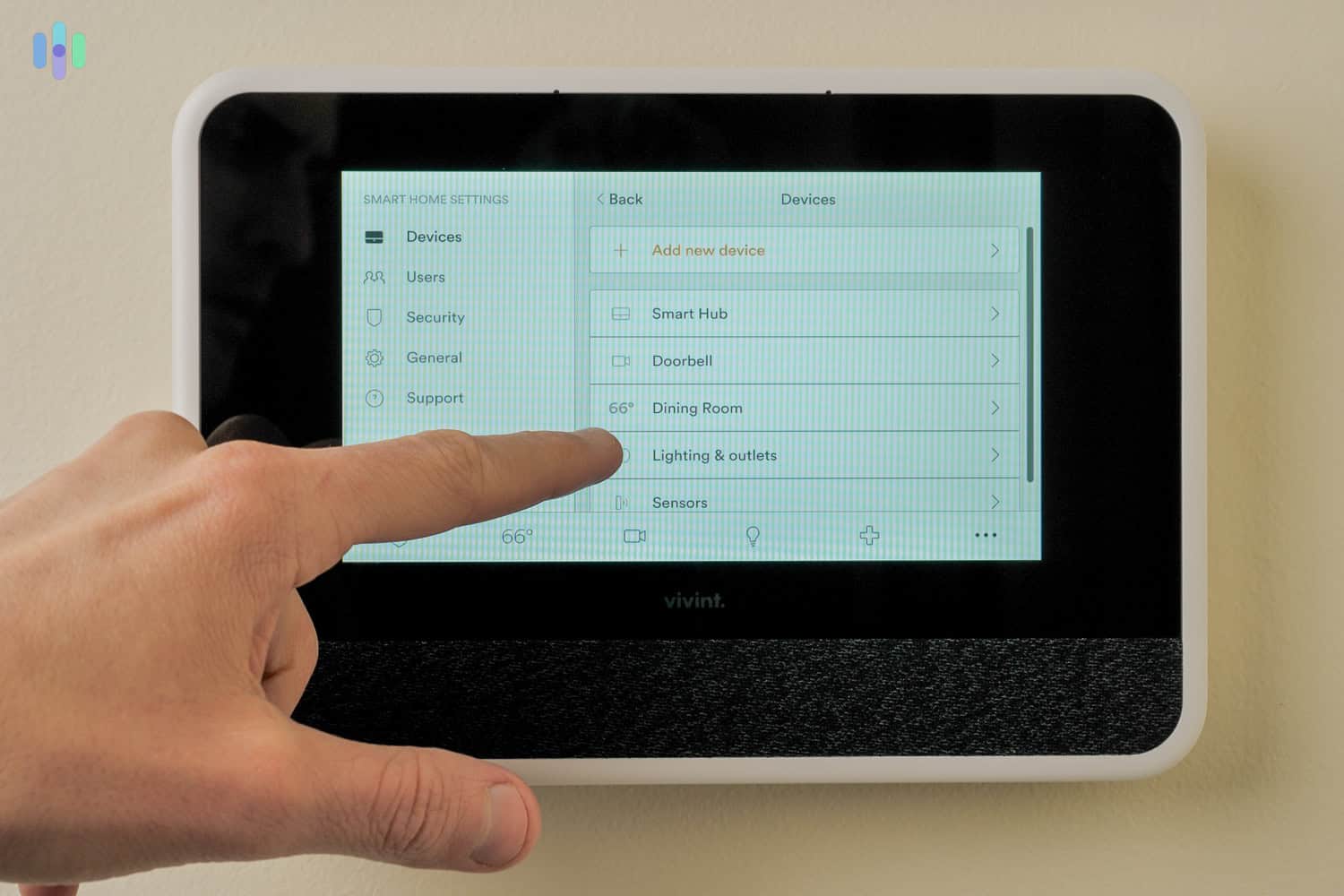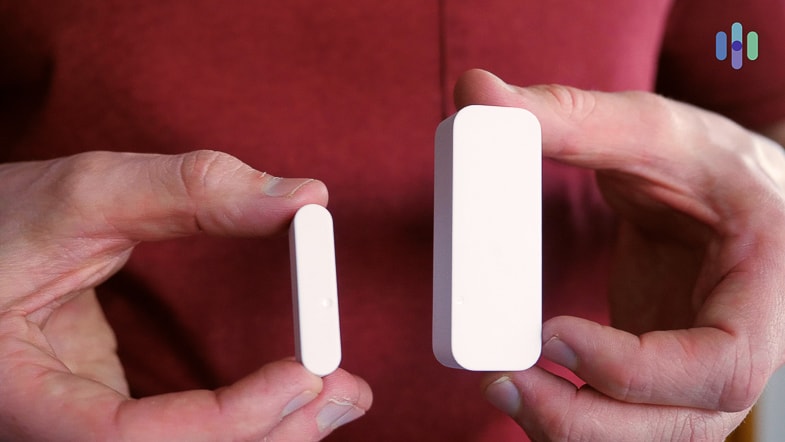Automating your home is a big, exciting change with plenty of rewards. You can have instant light when you walk into a room, heating when you need it, and hot coffee when you wake up in the morning. From a home security vantage point, automation also means a self-arming (and disarming) home security system that knows when you’re home and what to do to keep you safe.
>> Also: The Best Smart Home Security Systems of 2025
All these benefits require know-how. In this smart home security guide, we’re going to lead you through the basics of home automation and how it works so you can set up your smart home to run seamlessly, safely, and efficiently.
FYI: Smart devices are often called Internet of Things (IoT) devices because they communicate with each other through the internet over Wi-Fi and other popular wireless protocols like Zigbee and Z-Wave. Smart bulbs, smart thermostats, and smart locks, are all examples of popular IoT home automation devices.
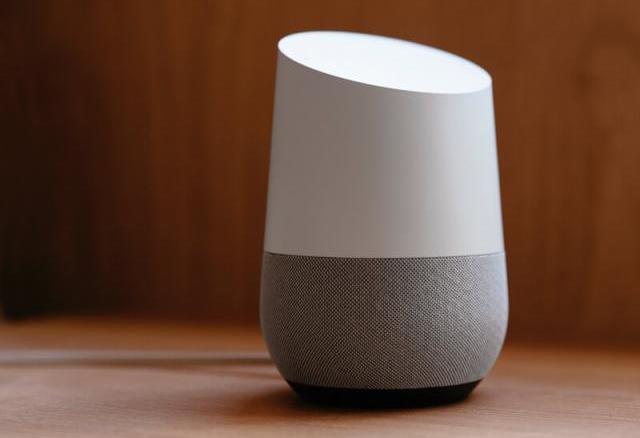
What Is Home Automation?
Home automation uses schedules, rules, and scenes to trigger smart devices to do things for us.
- Schedules make something happen at a fixed time; for example, your living room lights turn on at 5:30 p.m. every weekday evening in the winter.
- Rules make your devices respond to specific actions; for example, your kitchen lights turn on only when someone is in the kitchen.
- Scenes group devices so each performs a specific action when triggered. Your blinds raise, for example, and your Google Nest Mini reads your calendar when you wake up in the morning.

Pro Tip: Home automation makes life more convenient, but it can also save you money on heating, cooling, and electricity bills and make your home safer with IoT devices like security cameras and systems.
How Does Home Automation Work?
Home automation has three main components that work together: a hub, a network, and devices. Very basically they work like this:
- The hub gives the commands.
- The network communicates the commands over Wi-Fi, Bluetooth, Zigbee/Z-Wave, and now Thread.
- Smart devices receive the commands and carry them out.
For example, to have light in your living room at 5:30 every winter evening, you would first program your hub. This could be a Google Nest Hub Max or an Amazon Echo Show. It could also be a local (non-cloud-based) option like Home Assistant, or just your smartphone with an automation app such as IFTTT.
>>Learn More: The Best Home Security Systems for Alexa
Your hub would then send the command over Wi-Fi, Zigbee, or Thread. And, finally, your smart bulb (with a motion sensor) would receive the message and flip on the lights for you automatically.
Did You Know: For many years, intercompatibility between device manufacturers like Apple, Amazon, and Google was a huge issue. Now, with the introduction of the interoperable Matter protocol,1 all our IoT devices should be speaking the same language soon.

How To Set Up Home Automation
Home automation connects a network of smart devices and allows them to communicate with each other to perform functions around your home. Here’s how you can get your smart devices working together to automate your home.
Choose a Hub or Controller
Our larger Google Home Smart Speaker serves as our hub in our living room
Ideally, having one base of operations (hub) where you program and control all your smart devices makes the most sense for home automation. This can be trickier than it sounds because not all of our devices speak the same language yet. Here are three hub scenarios you may find yourself in when automating your home.
- Mobile app only. Some apps can run as home automation engines, allowing you to integrate and automate internet-connected smart home devices. IFTTT is perhaps the most popular example. It works with both cloud services (e.g. calendar, weather, productivity apps) and physical devices (including IFTTT-compatible security systems) over a cloud connection.
- Hub and app. In this scenario, your device works with Google (or Apple or Amazon), so you can control it via your smart speaker or display acting as a hub. Still, your devices communicate over the cloud. Your smart bulb and smart speaker aren’t “talking” directly in your home; they’re connected through their respective online services.
- Hub only. Here your device is Matter-ready, meaning it speaks a universal device language. You can add it to your hub of choice directly without any outside setup and control it from there. This is the easiest, most convenient solution for home automation and will become the standard.
FYI: Some systems support both hub-and-app and hub-only operations. Vivint’s Smart Hub is an example. It can directly talk to devices over the Z-Wave wireless protocol, but it also supports over-the-cloud integrations with Nest Thermostats and Alexa and Google smart speakers. See our Vivint review for more.
Understand Your Network
The most typical network set-up for automated homes is hybrid. Low-power devices like smart bulbs and motion sensors communicate locally with Bluetooth, Zigbee, or Z-Wave, then with the Cloud via your Wi-Fi connection. Here’s a quick breakdown of the ways hubs communicate with our devices.
- Wi-Fi. When you use Wi-Fi, your IoT devices use your internet connection. While this is convenient, it’s also resource-heavy and can crowd your network resulting in slower speeds, especially if you have a lot of different IoT devices running at once.
- Bluetooth: Bluetooth is a lighter, mesh technology that lets you control and monitor IoT devices and automate systems without Wi-FI.
- Z-Wave: Z-Wave is another wireless technology that won’t interfere with your Wi-Fi, operating, instead, on a low-power 908.42 Mhz frequency in the U.S. and Canada.
- Zigbee: Similar to Z-Wave, ZigBee is a mesh network and universal language that lets IoT devices communicate.
>> Learn More: Z-Wave versus ZigBee
- Thread: Thread is a newer low-power, wireless mesh networking protocol based on an IP address open standard. Thread will be the standard protocol moving forward.

Connect Your Devices
After you’ve chosen your hub and decided on the type of network set-up you want to use, the final step in automating your home is connecting your devices to your network via your hub or their dedicated apps and programming them. Here’s a breakdown of the most common smart home devices and the network protocols they typically require.
>> Check Out: Our Top Smart Home Device Picks of 2025
| Device | Wi-Fi | Zigbee | Z-Wave | Thread |
|---|---|---|---|---|
| Smart Speakers/Hubs | Yes | Yes | Yes | Yes |
| Smart Plug | Yes | Yes | Yes | Yes |
| Smart Light Bulb | Yes | Yes | No | Yes |
| Smart Switch | Yes | Yes | Yes | Yes |
| Smart Thermostat | Yes | No | No | Yes |
| Door/Window Sensor | No | Yes | Yes | Yes |
| Motion Sensor | No | Yes | Yes | Yes |
| Water Leak Sensor | No | Yes | Yes | Yes |
| Smoke/CO Detector | Yes | Yes | Yes | Yes |
| Smart Lock | Yes | Yes | Yes | Yes |
| Video Doorbell | Yes | No | No | No |
| Security Camera | Yes | No | No | No |
| Garage Door Controller | Yes | Yes | Yes | No |
| Smart Blinds | Yes | Yes | Yes | Yes |
Pro Tip: Some low-power Matter-enabled devices — smart bulbs and thermostats, for example — communicate over a Thread mesh network, not Wi-Fi. So if you have Matter-ready devices, look for a Thread-ready hub like an Apple HomePod or TV, a Google Nest Hub (2nd Gen), or an Amazon Echo (4th Gen and up) when setting up your smart home.
Should I Use a Cloud or Local Network for My Smart Home?
Not all hubs need to communicate with the cloud to automate homes. Some hubs automate devices locally using technologies like Zigbee, Z-Wave, Bluetooth, and now Thread. If online privacy is a concern, you might want to look into a smart home hub that automates your devices without accessing the cloud. Just be aware that the top home security systems usually require an internet connection.
>> Related: Can My Security Camera Be Hacked?
Here are some common hubs with the network technologies they use, including a few alternatives that favor local automations.
| Hub | Wi-Fi | Zigbee | Z-Wave | Thread |
|---|---|---|---|---|
| Nest Hub (2nd Gen) | Yes | No | No | Yes |
| Amazon Echo 4th Gen | Yes | Yes | No | No |
| Home Assistant | Yes | Yes | Yes | Yes |
| Hubitat Elevation | Limited | Yes | Yes | No |
| SmartThings Hub v3 | Yes | Yes | Yes | No |
| Vivint Smart Hub | Yes | No | Yes | No |
Pro Tip: Whenever a device connects to the cloud, it’s vulnerable to hackers, even devices like security cameras. So when setting up your home automation hub, review home security basics, avoid notoriously unsafe brands, and invest in quality security equipment with a reputation for safety.
IoT Features
Once you’ve got your smart devices set up, there’s a lot you can do to make your smart home smarter and safer.
- Remote control. Obvious, but worth pointing out; when you transition to a smart home, all the tweaks you make to your smart devices will be by remote control, i.e. either by hub, speaker, or app.
- Voice assistants. Most IoT devices can also be controlled by voice commands via voice assistants like Alexa, Siri, and Google Assistant.
- Schedules. As we mentioned above, you can schedule most IoT devices to turn off and on automatically at set times.
- Scenes let you group devices in one place to perform synchronized actions. Lights on, Spotify on, for example.
- Geofencing triggers actions based on your current location, usually determined by the GPS on your phone. For instance, when you’re 10 feet away from your front door, your door unlocks itself.
- Home and away modes. Some smart home products like bulbs can be set to home and away modes. Away mode would turn turn lights on and off at random to give snoopers the impression that you’re home.
- Energy monitoring. Some smart bulbs and thermostats show you exactly how much energy you’re using so you can see how much money you’re saving.
- Sunrise and sunset mode. Syncing your smart bulbs with sunrise and sunset is ideal for maintaining your Circadian rhythm.
- Shared access lets other family members control your devices. If you’ve got kids, be careful here.
- Triggers let devices from the same or different manufacturers trigger one another, depending on their compatibility. For example, Ring security devices also work with third-party IoT devices from companies like Dome, First Alert, EcoLink and GE, giving you more home automation opportunities.
Is Home Automation Secure? Tips for Securing IoT Devices
With some IoT devices, digital security can be more of an afterthought, not originally built into many first-generation models. However, as security breaches become more commonplace, many manufacturers are changing their ways, making their IoT devices less hackable. But ultimately, it’s up to the user to take advantage of these digital security features. Here’s how:
- Secure router: One of the most straightforward ways to secure your home automation system is to use a secure router from a company other than your Internet Service Provider; we recommend looking into routers from NETGEAR, Linksys, and TP-Link.
- Privacy policy: Sure, it may be time-consuming and more than a little bit boring, but it’s important to actually read the company’s privacy policy to see what customer data they keep and how they share it and sell it to third parties.
- Name router: Be sure to give your router a name other than the one that it came with.
- Encryption: Choose a strong encryption method for your WiFi, like WPA2.
- WiFi password: Make sure your WiFi network has a long, complicated, and unique password. Of course, this makes it harder to add guests, but it also prevents others from hopping on (and hacking your IoT devices).
- Separate WiFi network: For the most security for your IoT devices, consider getting a separate WiFi network for IoT devices only. This will also create faster Internet speeds all around.
- Password hygiene: Aside from your WiFi network, your IoT account should have a password that’s not repeated on any other account; no old, weak or repeated passwords allowed!
- Device settings: Often, devices have features enabled by default that aren’t necessary, and that can make your IoT devices more hackable. Be sure to turn off these features when not in use, like WiFi, Bluetooth, and knowing your location.
- Software updates: Although change can be scary, software updates are a good thing! They often include updates specifically targeted at improving digital security, so be sure to perform all software updates as soon as they’re available.
- Authentication: Some companies like Ring have added two-factor authentication to their accounts, meaning to sign in, we had to enter a passcode that was sent to our phones. This made sure that only us, the authorized users, could access our accounts. For even more authentication, look for accounts that allow for fingerprint or facial ID, known as multi-factor authentication. You can also add on either type of authentication through a password manager; for example, we use NordPass’ Touch ID to access all accounts on our iPhones.
- VPN: Finally, if you’re using an IoT device on a public Wi-Fi network, like a smart plug powering your laptop in a coffee shop, connect to a VPN, or Virtual Private Network, to encrypt your web traffic and hide your IP
While no action can prevent hacking 100 percent, you can greatly reduce your likelihood of being hacked with only a few simple steps.
Should I Automate My Home?
Many households have already automated in little ways, but making full-scale renovations requires planning and consideration. Here are some things to think about before you begin automating your home.
Pros
- Remote access. You can control devices like door locks remotely so you won’t have to leave keys under the mat anymore for kids or the dog sitter.
- Convenience. Talking to your devices is a lot easier than opening up an app and fiddling with them. Setting schedules also means you don’t have to remember to turn off the thermostat, lock the front door, or arm your security system.
- Savings. Smart homes use energy more efficiently, so you should expect to save money over the long run. Many home insurance companies also offer discounted premiums for smart homes.
- Security. Most smart homes also integrate security products like door and window sensors, security cameras, and video doorbells. Numerous security studies point to the fact that when criminals know they’re being watched, they commit less crime.
FYI: Property crime has dropped steeply since COVID,2 in part because more homes have installed home security. Personal cybercrime, on the other hand, has skyrocketed with a 33-percent increase over 2024 with losses totalling $16 billion, per the FBI’s latest numberst.3
Cons
- Costs. IoT devices are more expensive than their “dumb” counterparts. For example, the average smart bulb costs around $32, while the average regular light bulb is about $5. The same goes for smart plugs, smart switches, and smart thermostats. Automating your home isn’t going to be cheap.
- Security vulnerabilities. Anything that uses the internet, even browsing Etsy, is vulnerable to hackers. That includes IoT devices.
- New technology. Since IoT is a relatively new technology, you’re going to run into bugs and issues with interoperability.
- Surveillance: Many smart devices communicate with the cloud, sharing details of our private routines: when we get up, what we listen to, our plans for the day. Unless you opt for an entirely local automation system that doesn’t share any data with data gatherers like Google, Amazon, and Apple, you’ll have to decide if the convenience is worth the intrusion.
>> Learn More: The Data Big Tech Has on You
Home Automation Security Checklist
As we said above, any equipment in your home that communicates with another piece of equipment in or outside your home is a potential security risk, even smart bulbs.4 The good news is, many manufacturers have started paying attention to IoT device vulnerabilities. But ultimately, our digital security is up to us. So before we sign off, here are some tips for making your automated smart home more secure:
- Read privacy policies. Before you purchase an IoT device for your home, read the manufacturer’s privacy policy to see what customer data they keep, how they use it, and if they sell it to third parties.
- Purchase a secure router: The National Security Agency recommends securing your home automation system with a secure router from a company other than your internet service provider.5 This is good advice. Our personal preference is routers from NETGEAR, Linksys, and TP-Link.
- Find a router that allows VPNs: This requires a little more technical know-how than just setting up a VPN for your laptop or mobile devices, but it guarantees all your connected devices are safe from hackers and snoops. For more VPN basics, see our complete guide to VPNs.
- Name your router: Give your router a new name, or SSID. Default SSIDs, typically manufacturer and model names, tell hackers what equipment you’re using, making it easier for them to target you. Follow these instructions to change your SSID.
- Follow encryption best practices: Choose a strong encryption method for your WiFi. WPA3 is the new gold standard.
- Create secure passwords: Make sure your Wi-Fi network, and all your IoT accounts, have secure passwords. This makes it harder to add guests manually, but it also makes it trickier for parasites and criminals to hop on to you network and hack your IoT devices.
>> Also: Generate Strong Passwords for Free
- Use separate Wi-Fi networks: Creating a separate Wi-Fi network for guests is a home security best practice. But you can also create a separate network for your IoT devices. This way, if a cybercriminal manages to hack into a smart device, they can’t break into your computing gear.
- Device settings: Often IoT devices have features enabled by default that aren’t necessary, features like Wi-Fi, Bluetooth, and geo-location. This can make them more hackable, so be sure to turn those features off when you’re not using them.
- Update software and firmware immediately. Unpatched firmware and software are huge vulnerabilities for your devices, smart and otherwise, so update them as soon as the fixes are rolled out.
Final Thoughts
With smart devices, and now AI, machines are doing more and more for us. By and large, this is a positive step. For smart homes, specifically, this means more convenience and safety and lower energy bills.
Just make sure you take a moment to learn the basics of home automation outlined in this guide, and to plan your overhaul. And, as always, be wary of bad actors. For every technological advance we make, there are thousands of fraudsters willing and skilled enough to exploit it.
Home Automation FAQ
-
Is automating my home safe?
Every smart device is potentially hackable, but if you follow the smart home security guidelines outlined above, you’ll reduce your risk substantially.
-
What’s an IoT device?
An IoT device is a smart device that communicates with other devices on your home network and often with the cloud.
-
How do I know if my IoT devices are compatible?
If you use a modern hub and Matter-ready devices, all your devices will work together with your hub. For older devices and hubs, interoperability isn’t guaranteed.
-
What’s the best hub for my smart home?
Check out our smart home buying guide and our top smart home device picks above.
-
Will automating my home save me money?
Yes, over time automating your home should save you money in energy bills. Many home insurance companies also offer discounts for smart homes with security systems.



